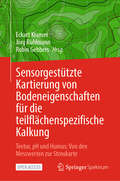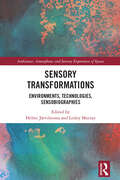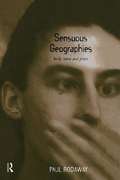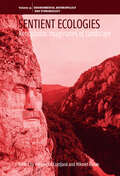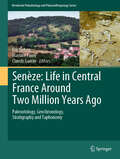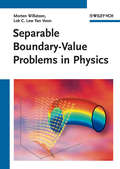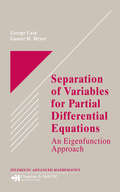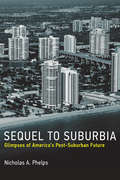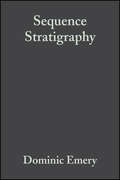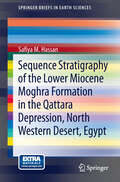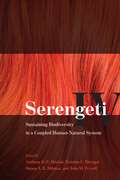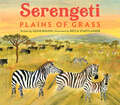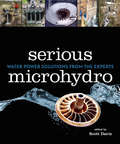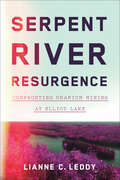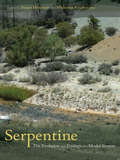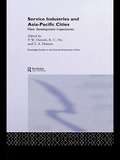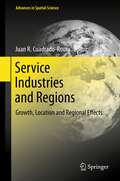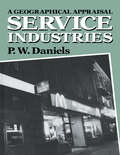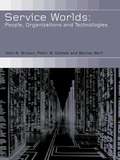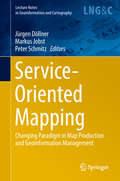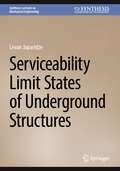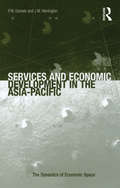- Table View
- List View
Sensorgestützte Kartierung von Bodeneigenschaften für die teilflächenspezifische Kalkung: Textur, pH und Humus: Von den Messwerten zur Streukarte
by Eckart Kramer Jörg Rühlmann Robin GebbersDieses Open Access Buch vermittelt fundierte Grundlagen und praxisorientierte Anleitungen für die genaue Kartierung von Ackerflächen auf der Grundlage von Bodenparametern wie Textur, pH-Wert und Humusgehalt. Es werden die gegenwärtig bestgeeigneten Kartierungsverfahren beschrieben. Von der Bereinigung der Bodensensordaten bis hin zur Erstellung von Streukarten und der Auswahl des optimalen Kalkdüngers wird jeder Schritt des Prozesses detailliert erklärt. Sämtliche Funktionen und Algorithmen zum Buch sind als “R”-Skripte via Download verfügbar. Mit Hilfe von Beispieldaten und einem Tutorial kann die Prozesskette zur Streukartenerstellung mit der freien Softwareumgebung “R” als Einstieg in mathematische Methoden des Precision Farming, u.a. räumliche Statistik und Entscheidungsunterstützungsalgorithmen, nachvollzogen werden. Darüber hinaus bietet dieses Buch praktische Einblicke in die landwirtschaftliche Praxis, indem es die Bedeutung präziser Bodentexturkarten für eine effiziente Grunddüngung erläutert. Anhand von anschaulichen Praxisbeispielen werden die Auswirkungen ungenauer Bodeninformationen auf die Nährstoffversorgung des Bodens und die Umwelt verdeutlicht. Mit seinem ganzheitlichen Ansatz liefert dieses Buch nicht nur praktische Anleitungen, sondern auch wertvolles Hintergrundwissen zu Fachthemen wie Bodenacidität, Kalkdüngestoffen und Kartierungsmethoden. Es ist ein idealer Begleiter für Landwirt*innen, Berater*innen und Wissenschaftler*innen, die ihre landwirtschaftlichen Praktiken optimieren und ihre Erträge steigern möchten.
Sensory Transformations: Environments, Technologies, Sensobiographies (Ambiances, Atmospheres and Sensory Experiences of Spaces)
by Lesley Murray Helmi JärviluomaThis book offers original insights into cultural transformations of the sensory with particular emphasis on environments and technologies, articulating a special moment in the sensory history of urban Europe as people’s relationship with their environment is increasingly shaped through digital technologies. It is a much-needed addition to Sensory Studies literature with its firmly grounded empirical and theoretical perspectives. It provides radical and impactful food for thought on sensory engagements with urban environments. After reading the book, the reader will have a profound understanding of the original methodology of sensobiographic walking, as well as transdisciplinary and transgenerational ethnographies in different cultural contexts – in this case three European cities. The book is aimed at a large audience of readers. It is equally useful for social and human scientists and students finalizing their MA degrees or working on their doctoral or post-doctoral work, and essential reading for environmental planners, youth workers, city planners and architects, among others.
Sensuous Geographies: Body, Sense and Place
by Paul RodawayThe contemporary challenge of postmodernity draws our attention to the nature of reality and the ways in which experience is constructed. Sensuous Geographies explores our immediate sensuous experience of the world. Touch, smell, hearing and sight - the four senses chiefly relevant to geographical experience - both receive and structure information. The process is mediated by historical, cultural and technological factors. Issues of definition are illustrated through a variety of sensuous geographies. Focusing on postmodern concerns with representation, the book brings insights from individual perceptions and cultural observations to an analysis of the senses, challenging us to reconsider the role of the sensuous as not merely the physical basis of understanding but as an integral part of the cultural definition of geographical knowledge.
Sentient Ecologies: Xenophobic Imaginaries of Landscape (Environmental Anthropology and Ethnobiology #31)
by Alexandra Coțofană Hikmet KuranEmploying methodological perspectives from the fields of political geography, environmental studies, anthropology, and their cognate disciplines, this volume explores alternative logics of sentient landscapes as racist, xenophobic, and right-wing. While the field of sentient landscapes has gained critical attention, the literature rarely seems to question the intentionality of sentient landscapes, which are often romanticized as pure, good, and just, and perceived as protectors of those who are powerless, indigenous, and colonized. The book takes a new stance on sentient landscapes with the intention of dispelling the denial of “coevalness” represented by their scholarly romanticization.
Senèze: Paleontology, Geochronology, Stratigraphy and Taphonomy (Vertebrate Paleobiology and Paleoanthropology)
by Eric Delson Martine Faure Claude GuérinThe paleontological site of Senèze (Haute Loire, central France) was discovered in 1892 inside a volcanic crater. For over 40 years, local peasant Pierre Philis collected fossils and sold them to French and Swiss museums. The site became world-famous for its well-preserved skeletons of ungulates and carnivores, as well as rare but well-preserved remains of primates and other mammals. It is considered the reference fauna for the late Villafranchian and MNQ 18 biochronological units of European mammalian evolution, but the lack of provenance data made modern research difficult. From 2000-2006, the multidisciplinary Franco-American Senèze Research Project undertook five seasons of major fieldwork, with the goals of clarifying the age, stratigraphy and taphonomy of Senèze, as well as finding additional remains, especially of the less well-known taxa. In this volume, following a history of study and summary of the new fieldwork, four geological chapters consider field methods, stratigraphy, volcanology and dating. Combining argon-argon ages and paleomagnetic calibration, the newly recovered fossils are shown to date between 2.20 and 2.08 Ma, with concentrations ca. 2.20-2.18 and 2.10-2.08 Ma, significantly older than previously thought. Chapters on palynology, ichthyology and ornithology are followed by eight chapters on the fossil mammals. The chapter on biochronology places Senèze among other sites at the start of MNQ 18, which is estimated to end ca. 1.7 Ma. Of some 2200 specimens known from the site, over half are cervids, with bovids, rhinocerotids and equids far behind. According to data from palynology and the habitat preferences of the more common mammals, the paleoenvironment around the Senèze maar would have included forest, woodland and grassland, perhaps in a warmer and moister climate than today. Taphonomic studies revealed that bones often rested a long time under water, lacked any indication of carnivore attack and often displayed pathologies in their joints. It is likely that most of the associated skeletons were preserved undisturbed after large mammals fell into the paleolake and drowned without being able to climb out. This book responds to the long-held desire of later Cenozoic paleontologists to see a modern study of a site recognized worldwide as a biochronologic reference for the Plio-Pleistocene. Our study required renewed fieldwork using up to date techniques of topography, sedimentology, stratigraphy, geochronology and taphonomy. The systematic paleontology chapters are based on re-study of the entire body of Senèze fossils collected during more than a century of research. The volume will be of interest to paleontologists, especially those concerned with the evolution of the European fauna and with the taxa studied, as well as with paleoenvironmental reconstruction and biogeography. It will also be of value to mammalogists interested in analyses of near-modern taxa and to paleoanthropologists, archaeologists and taphonomists interested in the methods utilized and the role of Senèze as a comparative standard for a site of this age without human intervention. It will surely be an essential reference for all those who want to know more about Life in Central France Around Two Million Years Ago.
Separable Boundary-Value Problems in Physics
by Morten Willatzen Lok C. Lew Yan VoonInnovative developments in science and technology require a thorough knowledge of applied mathematics, particularly in the field of differential equations and special functions. These are relevant in modeling and computing applications of electromagnetic theory and quantum theory, e.g. in photonics and nanotechnology. The problem of solving partial differential equations remains an important topic that is taught at both the undergraduate and graduate level. Separable Boundary-Value Problems in Physics is an accessible and comprehensive treatment of partial differential equations in mathematical physics in a variety of coordinate systems and geometry and their solutions, including a differential geometric formulation, using the method of separation of variables. With problems and modern examples from the fields of nano-technology and other areas of physics. The fluency of the text and the high quality of graphics make the topic easy accessible. The organization of the content by coordinate systems rather than by equation types is unique and offers an easy access. The authors consider recent research results which have led to a much increased pedagogical understanding of not just this topic but of many other related topics in mathematical physics, and which like the explicit discussion on differential geometry shows - yet have not been treated in the older texts. To the benefit of the reader, a summary presents a convenient overview on all special functions covered. Homework problems are included as well as numerical algorithms for computing special functions. Thus this book can serve as a reference text for advanced undergraduate students, as a textbook for graduate level courses, and as a self-study book and reference manual for physicists, theoretically oriented engineers and traditional mathematicians.
Separation of Variables for Partial Differential Equations: An Eigenfunction Approach
by George Cain Gunter H. MeyerSeparation of Variables for Partial Differential Equations: An Eigenfunction Approach includes many realistic applications beyond the usual model problems. The book concentrates on the method of separation of variables for partial differential equations, which remains an integral part of the training in applied mathematics. Beyond the usual model p
Sequel to Suburbia: Glimpses of America's Post-Suburban Future (Urban and Industrial Environments)
by Nicholas A. PhelpsHow the decentralized, automobile-oriented, and fuel-consuming model of American suburban development might change.In the years after World War II, a distinctly American model for suburban development emerged. The expansive rings of outer suburbs that formed around major cities were decentralized and automobile oriented, an embodiment of America's postwar mass-production, mass-consumption economy. But alternate models for suburbia, including “transit-oriented development,” “smart growth,” and “New Urbanism,” have inspired critiques of suburbanization and experiments in post-suburban ways of living. In Sequel to Suburbia, Nicholas Phelps considers the possible post-suburban future, offering historical and theoretical context as well as case studies of transforming communities.Phelps first locates these outer suburban rings within wider metropolitan spaces, describes the suburbs as a “spatial fix” for the postwar capitalist economy, and examines the political and governmental obstacles to reworking suburban space. He then presents three glimpses of post-suburban America, looking at Kendall-Dadeland (in Miami-Dade County, Florida), Tysons Corner (in Fairfax County, Virginia), and Schaumburg, Illinois (near Chicago). He shows Kendall-Dadeland to be an isolated New Urbanism success; describes the re-planning of Tysons Corner to include a retrofitted central downtown area; and examines Schaumburg's position as a regional capital for Chicago's northwest suburbs. As these cases show, the reworking of suburban space and the accompanying political process will not be left to a small group of architects, planners, and politicians. Post-suburban politics will have to command the approval of the residents of suburbia.
Sequence Stratigraphy
by Keith Myers Dominic EmeryThe innovation and refinement of the techniques and concepts of sequence stratigraphy has been one of the most exciting and profound developments in geology over the past thirty years. Seismic stratigraphy has now become one of the standard tools of the geoscientist, and there is a pressing need for an introductory text on sequence stratigraphy. This new book sets out to define and explain the concepts, principles and applications of this remarkably influential approach to the study of sedimentary strata. The authors take a rigorous objective stance in evaluating the techniques and interpretation of sequence stratigraphy - basing the text on an internal training course developed by British Petroleum (BP).
Sequence Stratigraphy of the Lower Miocene Moghra Formation in the Qattara Depression, North Western Desert, Egypt
by Safiya M. HassanThe Qattara Depression is part of the Northwestern Desert in Egypt and is home to the second lowest point in Africa at -133 meters below sea level. Therefore, before any projects can be carried out in this area, we must first understand the geology of the land. The present study deals with the high-resolution sequence stratigraphic analysis of the Lower Miocene Moghra Formation outcrops in the Qattara Depression Region. The literature on the sedimentology and sequence stratigraphy of the Moghra Formation has been sparse to date, despite some excellent work over the years by academic and petroleum workers. Moreover, the area studied is within what was once a front-line of World War II, where mine fields and war relics are scattered and cover wide reaches. This has resulted in limited geologic mapping in the past. Thus, great attention is paid in this study to establishing a robust sedimentology and high-resolution sequence stratigraphic framework for the Lower Miocene Moghra Formation. Included are works based on outcrops and, most importantly, new sedimentological and chronostratigraphic information not previously available.
Sequential Analysis and Observational Methods for the Behavioral Sciences
by Vicenç Quera Roger BakemanBehavioral scientists - including those in psychology, infant and child development, education, animal behavior, marketing and usability studies - use many methods to measure behavior. Systematic observation is used to study relatively natural, spontaneous behavior as it unfolds sequentially in time. This book emphasizes digital means to record and code such behavior; while observational methods do not require them, they work better with them. Key topics include devising coding schemes, training observers and assessing reliability, as well as recording, representing and analyzing observational data. In clear and straightforward language, this book provides a thorough grounding in observational methods along with considerable practical advice. It describes standard conventions for sequential data and details how to perform sequential analysis with a computer program developed by the authors. The book is rich with examples of coding schemes and different approaches to sequential analysis, including both statistical and graphical means.
Serengeti IV: Sustaining Biodiversity in a Coupled Human-Natural System
by John M. Fryxell Anthony R. E. Sinclair Kristine L. Metzger Simon A. R. MdumaThe vast savannas and great migrations of the Serengeti conjure impressions of a harmonious and balanced ecosystem. But in reality, the history of the Serengeti is rife with battles between human and non-human nature. In the 1890s and several times since, the cattle virus rinderpest at last vanquished in 2008 devastated both domesticated and wild ungulate populations, as well as the lives of humans and other animals who depended on them. In the 1920s, tourists armed with the world s most expensive hunting gear filled the grasslands. And in recent years, violence in Tanzania has threatened one of the most successful long-term ecological research centers in history. "Serengeti IV," the latest installment in a long-standing series on the region s ecology and biodiversity, explores the role of our species as a source of both discord and balance in Serengeti ecosystem dynamics. Through chapters charting the complexities of infectious disease transmission across populations, agricultural expansion, and the many challenges of managing this ecosystem today, this book shows how the people and landscapes surrounding crucial protected areas like Serengeti National Park can and must contribute to Serengeti conservation. In order to succeed, conservation efforts must also focus on the welfare of indigenous peoples, allowing them both to sustain their agricultural practices and to benefit from the natural resources provided by protected areas an undertaking that will require the strengthening of government and education systems and, as such, will present one of the greatest conservation challenges of the next century. "
Serengeti: Plains of Grass
by Leslie BulionAward-winning science poetry master Leslie Bulion presents a lyrical salute to Africa's Serengeti Plain, one of the most spectacular and productive ecosystems on Earth.Leslie Bulion, a virtuoso science poet, has created a portrait of the rainy season on East Africa's southern Serengeti Plain, offering young readers a compelling look at an ecosystem in motion. Using a series of interconnected verses inspired by an East African Swahili poem form—the utendi—Bulion's cadences and rhythmic lines mimic the web of life in the Serengeti, following the great migration of wildebeest, zebras, and other animals into and then out of the vast short-grass plain. Lush, evocative gouache illustrations by Becca Stadtlander showcase the grandeur of this immense and complex ecosystem and provide close-up details of its wildlife inhabitants. Scientific notes on each spread and comprehensive back matter material offer more specifics. This, paired with Bulion's brilliant poetic form, makes the book ideal for cross-curricular learning. A Booklist Editors&’ Choice Selection <P><P><i>Advisory: Bookshare has learned that this book offers only partial accessibility. We have kept it in the collection because it is useful for some of our members. Benetech is actively working on projects to improve accessibility issues such as these.</i>
Serious Leisure and Nature
by Robert A. Stebbins Lee DavidsonOutings in nature considered as leisure activity constitute a main way in which many people the world over presently use their free time. Nature is defined here as any natural setting perceived by users as at most only minimally modified by human beings. In its most general manifestation nature thus defined is composed of one or more of six elements: air, land, water, plants, animals (birds, fish) and snow or ice. Outdoor pursuits are immensely popular, especially among city dwellers. They are also widely discussed in leisure studies, where they have inspired considerable research. Still this research tends to lack a theoretic anchor, which this book provides through the new serious leisure concept of nature challenge activity (NCA). It examines several hundred NCAs and types of NCAs, setting out how meeting this challenge unfolds in an aesthetically appealing natural environment with notable implications for consumption and environmental sustainability.
Serious Microhydro
by Scott DavisWaterpower is the largest source of renewable energy in the world today, and microhydro is a mature, proven technology that can provide clean, inexpensive, renewable energy with little or no impact on the environment. Serious Microhydro brings you dozens of firsthand stories of energy independence covering a complete range of systems, from household pressure sites to higher pressure installations capable of powering a farm, business, or small neighborhood. Topics include: Low head and medium head sites AC-only systems as well as ones using a battery/inverter subsystem Stand alone power supply or grid intertie setups Hybrid systems (combined with photovoltaics or wind) With all the variables involved in microhydro, there is no "typical" system. These case studies represent the most comprehensive collection of knowledge and experience available for tailoring an installation to meet the needs of a site and its owner or operators. If you are considering building a system, you are bound to find a wealth of creative solutions appropriate to your own circumstances. Serious Microhydro shows how scores of people are achieving a high standard of living from local energy sources with a minimal ecological footprint. It has particular appeal to homeowners, teachers, renewable energy professionals, activists, and decision makers who want to understand the technology from a "hands-on" perspective. Scott Davis is an award-winning renewable energy project developer with decades of experience operating, installing, designing, selling, and teaching microhydro technology. He is a founder and president of Friends of Renewable Energy BC, and the author of Microhydro: Clean Power From Water.
Serpent River Resurgence: Confronting Uranium Mining at Elliot Lake
by Lianne C. LeddySerpent River Resurgence tells the story of how the Serpent River Anishinaabek confronted the persistent forces of settler colonialism and the effects of uranium mining at Elliot Lake, Ontario. Drawing on extensive archival sources, oral histories, and newspaper articles, Lianne C. Leddy examines the environmental and political power relationships that affected her homeland in the Cold War period. Focusing on Indigenous-settler relations, the environmental and health consequences of the uranium industry, and the importance of traditional uses of land and what happens when they are compromised, Serpent River Resurgence explores how settler colonialism and Anishinaabe resistance remained potent forces in Indigenous communities throughout the second half of the twentieth century.
Serpentine: The Evolution and Ecology of a Model System
by Susan Harrison Nishanta RajakarunaSerpentine soils have long fascinated biologists for the specialized floras they support and the challenges they pose to plant survival and growth. This volume focuses on what scientists have learned about major questions in earth history, evolution, ecology, conservation, and restoration from the study of serpentine areas, especially in California. Results from molecular studies offer insight into evolutionary patterns, while new ecological research examines both species and communities. Serpentine highlights research whose breadth provides context and fresh insights into the evolution and ecology of stressful environments.
Service Industries and Asia Pacific Cities: New Development Trajectories (Routledge Studies in the Growth Economies of Asia)
by K. C. Ho P. W. Daniels T. A. HuttonDuring the second half of the twentieth century, development in the Asia-Pacific region has been dominated by industrialization. However, at the beginning of the twenty-first century, services, in particular, finance, information and creative services, have become deeply embedded in the processes of urban growth. In Asia-Pacific the rise of service industries has lead to national modernization programmes and globalization strategies. Services are also driving change in the internal form of city regions and are being actively deployed as instruments of metropolitan reconfiguration and land use changes. These changes have created problems such as social polarization and the displacement of traditional industries and residential districts. Also, there are tensions between local and global processes in the development of service industries, and between the imperatives of competitive advantage and sustainable development.Service Industries and Asia Pacific Cities brings together a multi-disciplinary team of experts to explore and illustrate the theoretical, conceptual and practical issues arising from the transformation of Asia-Pacific cities by service industries.
Service Industries and Regions
by Juan R. Cuadrado-RouraThe service sector in most advanced economies accounts for up to seventy percent of employment and GDP and, given its growing importance, has received much research attention over the last two decades. However, not very much attention has been paid to the relationship between this sector and both its territorial impact and regional effects. The main objective of this book is to offer a comprehensive approach to these aspects, focusing particularly on the location factors of service industries and the importance of some specific services, such as business services and knowledge and information services. The contributions have been prepared by well-known experts in the field from a wide number of countries. The focus of all contributions is not only on theoretical aspects, but also provides empirical analyses on specific countries and topics such as the geographical concentration, globalization impacts, foreign direct investments, and innovation.
Service Industries: A Geographical Appraisal
by Peter W. DanielsFirst published in 1985. Routledge is an imprint of Taylor & Francis, an informa company.
Service Provision and Rural Sustainability: Infrastructure and Innovation (Perspectives on Rural Policy and Planning)
by Laura Ryser Sean Markey Greg HalsethAccess to quality services and community infrastructure are vital parts of supporting sustainable and resilient rural and small town places. Renewing outdated infrastructure and supporting the delivery of services in rural communities present significant challenges from the constrained fiscal and policy realities of the 21st century. Drawing upon contributors from five Organization for Economic Co-operation and Development (OECD) countries, this book describes innovative service delivery and community infrastructure models that are appropriate to the contemporary rural and resource-dependent regions of developed economies. The examples show that an entrepreneurial approach to service delivery and infrastructure provision by local organizations and governments is needed. Critical economic and community development supports are crucial to assist creative and innovative sets of solutions that work for small communities. Chapters in this book argue that community development foundations for resilient rural and small town communities and regions must be co-constructed and co-delivered in partnership by both local and senior government actors, in terms of both policy and committed resources. This volume will be extremely valuable for students, scholars, and community development practitioners exploring policy-making, government initiatives, and community service provision in rural and small town places.
Service Worlds: People, Organisations, Technologies (The\royal Geographical Society With The Institute Of British Geographers Studies In Geography Ser.)
by Barney Warf John Bryson Peter DanielsAs the twenty-first century begins, significant changes are occurring in the way that services and goods are produced and consumed. One of the key drivers of this change is information and communications technology (ICT). It has transformed the role of space and time in patterns of economic development, in the rise of globalization and in the scale and structure of organizations. ICT has therefore accelerated the process of continual change and evolution that is the hallmark of both the capitalist economy and of organizations. Giving a student-friendly account of the diversity of theoretical perspectives, this outstanding book aids understanding the evolving economic geography of advanced capitalist economies. A series of detailed firm and employees' case studies from Europe, North America and the Asia Pacific, are used to inform useful theoretical case studies, which also investigate the significance of increased blurring of the lines between services and manufacturing functions in the production and consumption process.
Service-Oriented Mapping: Changing Paradigm in Map Production and Geoinformation Management (Lecture Notes in Geoinformation and Cartography)
by Markus Jobst Jürgen Döllner Peter SchmitzThis book gathers various perspectives on modern map production. Its primary focus is on the new paradigm of “sharing and reuse,” which is based on decentralized, service-oriented access to spatial data sources. Service-Oriented Mapping is one of the main paradigms used to embed big data and distributed sources in modern map production, without the need to own the sources. To be stable and reliable, this architecture requires specific frameworks, tools and procedures. In addition to the technological structures, organizational aspects and geographic information system (GIS) capabilities provide powerful tools to make modern geoinformation management successful. Addressing a range of aspects, including the implementation of the semantic web in geoinformatics, using big data for geospatial visualization, standardization initiatives, and the European spatial data infrastructure, the book offers a comprehensive introduction to decentralized map production..
Serviceability Limit States of Underground Structures (Synthesis Lectures on Mechanical Engineering)
by Levan JaparidzeThe main topic of this book is the calculation of underground structures at the limit states of serviceability. It considers the main schemes typical for underground structures for various purposes, gives the corresponding mathematical models describing the main geo-mechanical and technological factors in the construction and operation of extended excavations. Generalized criteria are proposed for making a technically and economically justified solution of the problem of determining the optimal forms and sizes of workings, bearing capacity, type of support and its erection, depending on the structural features of the rock mass, the primary stress fields of gravitational, tectonic, seismic acting in it. and technological origins, operational requirements for extended excavations. The corresponding algorithms, block diagrams and specific numerical examples of calculations are given. In most of the existing calculation methods the structure is considered in the elastic stage, the strength limit of the bearing capacity is considered as the moment when the maximum internal stresses reach the corresponding design resistances of the material. If it is legitimate to use this criterion in certain cases of calculation of statically determinable structures operating in the given loading mode, then in cases where the support operates in the mode of mutually influencing deformation together with the rock mass, it leads to a significant waste of material.
Services and Economic Development in the Asia-Pacific (The Dynamics of Economic Space)
by J.W. HarringtonUntil the 1990s, industrialization was the dominant development paradigm for the Asia-Pacific region. Since then, advanced services (finance, business or 'producer services', information and creative services) have become deeply embedded in the processes of economic growth and change in the region. This rapid tertiary expansion is fundamentally restructuring national and regional economies and urban form in line with the introduction of advanced production systems, national modernization programmes and the globalization strategies of governments. Services are being actively deployed as instruments of metropolitan reconfiguration and land use change. This book explores various aspects of the relationship between service industries and economic development in Japan, South Korea, China, Taiwan, Singapore, India, Australia and New Zealand. It provides new sector-oriented and regional and national perspectives on services and development.
